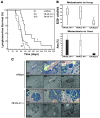TRAIL-R deficiency in mice promotes susceptibility to chronic inflammation and tumorigenesis
- PMID: 18079962
- PMCID: PMC2129232
- DOI: 10.1172/JCI29900
TRAIL-R deficiency in mice promotes susceptibility to chronic inflammation and tumorigenesis
Abstract
Preclinical data support the potential of the death-signaling receptors for TRAIL as targets for cancer therapy. However, it is unclear whether these death-signaling receptors suppress the emergence and growth of malignant tumors in vivo. Herein we show that TNF-related apoptosis-inducing ligand receptor (TRAIL-R), the only proapoptotic death-signaling receptor for TRAIL in the mouse, suppresses inflammation and tumorigenesis. Loss of a single TRAIL-R allele on the lymphoma-prone Emu-myc genetic background significantly reduced median lymphoma-free survival. TRAIL-R-deficient lymphomas developed with equal frequency irrespective of mono- or biallelic loss of TRAIL-R, had increased metastatic potential, and showed apoptotic defects relative to WT littermates. In addition, TRAIL-R-/- mice showed decreased long-term survival following a sublethal dose of ionizing radiation. Histological evaluation of moribund irradiated TRAIL-R-/- animals showed hallmarks of bronchopneumonia as well as tumor formation with increased NF-kappaB p65 expression. TRAIL-R also suppressed diethylnitrosamine-induced (DEN-induced) hepatocarcinogenesis, as an increased number of large tumors with apoptotic defects developed in the livers of DEN-treated TRAIL-R-/- mice. Thus TRAIL-R may function as an inflammation and tumor suppressor in multiple tissues in vivo.
Figures








Comment in
-
TRAIL-R deficiency in mice enhances lymph node metastasis without affecting primary tumor development.J Clin Invest. 2008 Jan;118(1):100-10. doi: 10.1172/JCI33061. J Clin Invest. 2008. PMID: 18079967 Free PMC article.
Similar articles
-
Induction of p53 renders ATM-deficient mice refractory to hepatocarcinogenesis.Gastroenterology. 2010 Mar;138(3):1155-65.e1-2. doi: 10.1053/j.gastro.2009.11.008. Epub 2009 Nov 14. Gastroenterology. 2010. PMID: 19919837
-
Persistent hepatocyte apoptosis promotes tumorigenesis from diethylnitrosamine-transformed hepatocytes through increased oxidative stress, independent of compensatory liver regeneration.Sci Rep. 2021 Feb 9;11(1):3363. doi: 10.1038/s41598-021-83082-7. Sci Rep. 2021. PMID: 33564095 Free PMC article.
-
Loss of immunity-supported senescence enhances susceptibility to hepatocellular carcinogenesis and progression in Toll-like receptor 2-deficient mice.Hepatology. 2013 Jan;57(1):171-82. doi: 10.1002/hep.25991. Hepatology. 2013. PMID: 22859216
-
The long and winding road to cancer treatment: the TRAIL system.Curr Pharm Des. 2014;20(17):2819-33. doi: 10.2174/13816128113199990588. Curr Pharm Des. 2014. PMID: 23944369 Review.
-
TRAIL/TRAIL-R in hematologic malignancies.J Cell Biochem. 2010 May;110(1):21-34. doi: 10.1002/jcb.22549. J Cell Biochem. 2010. PMID: 20336667 Review.
Cited by
-
Breast implant-associated ALK-negative anaplastic large cell lymphoma: a case report and discussion of possible pathogenesis.Int J Clin Exp Pathol. 2013 Jul 15;6(8):1631-42. Print 2013. Int J Clin Exp Pathol. 2013. PMID: 23923082 Free PMC article.
-
Tumour necrosis factor-related apoptosis-inducing ligand (TRAIL) in central nervous system inflammation.J Mol Med (Berl). 2009 Aug;87(8):753-63. doi: 10.1007/s00109-009-0484-x. Epub 2009 May 17. J Mol Med (Berl). 2009. PMID: 19449143 Review.
-
Cancer Immunosurveillance by Tissue-Resident Innate Lymphoid Cells and Innate-like T Cells.Cell. 2016 Jan 28;164(3):365-77. doi: 10.1016/j.cell.2016.01.002. Epub 2016 Jan 21. Cell. 2016. PMID: 26806130 Free PMC article.
-
Hypermethylation of tumor necrosis factor decoy receptor gene in non-small cell lung cancer.Oncol Lett. 2020 Jul;20(1):155-164. doi: 10.3892/ol.2020.11565. Epub 2020 Apr 22. Oncol Lett. 2020. PMID: 32565943 Free PMC article.
-
Regulation of the human TRAIL gene.Cancer Biol Ther. 2012 Oct;13(12):1143-51. doi: 10.4161/cbt.21354. Epub 2012 Aug 15. Cancer Biol Ther. 2012. PMID: 22892844 Free PMC article. Review.
References
-
- Boldin M.P., et al. A novel protein that interacts with the death domain of Fas/APO1 contains a sequence motif related to the death domain. J. Biol. Chem. 1995;270:7795–7798. - PubMed
-
- Chinnaiyan A.M., O’Rourke K., Tewari M., Dixit V.M. FADD, a novel death domain-containing protein, interacts with the death domain of Fas and initiates apoptosis. Cell. 1995;81:505–512. - PubMed
-
- Bodmer J.L., et al. TRAIL receptor-2 signals apoptosis through FADD and caspase-8. Nat. Cell Biol. 2000;2:241–243. - PubMed
-
- Kischkel F.C., et al. Apo2L/TRAIL-dependent recruitment of endogenous FADD and caspase-8 to death receptors 4 and 5. Immunity. 2000;12:611–620. - PubMed
-
- Sprick M.R., et al. FADD/MORT1 and caspase-8 are recruited to TRAIL receptors 1 and 2 and are essential for apoptosis mediated by TRAIL receptor 2. Immunity. 2000;12:599–609. - PubMed
Publication types
MeSH terms
Substances
Grants and funding
LinkOut - more resources
Full Text Sources
Other Literature Sources
Medical
Molecular Biology Databases

